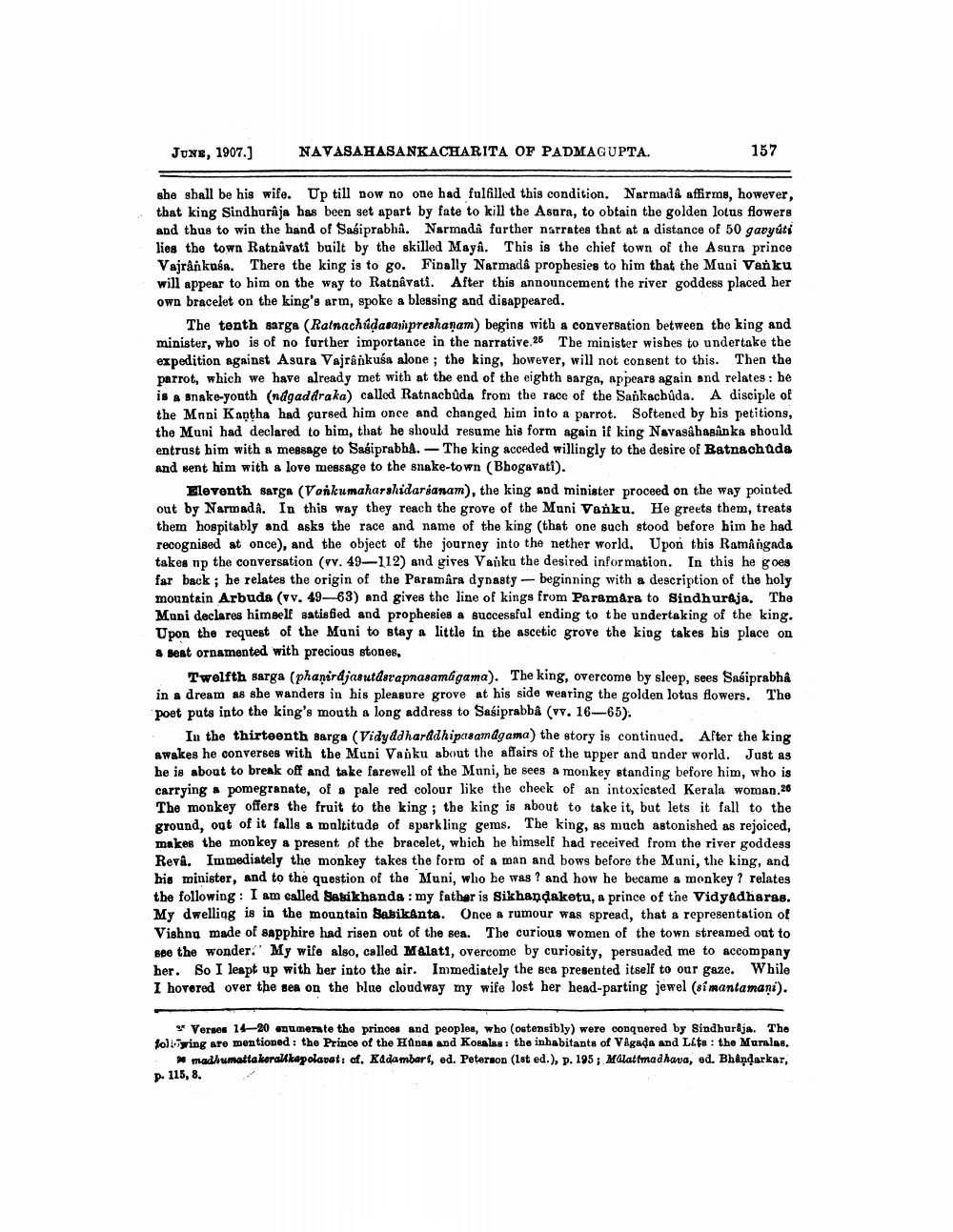________________
JUNE 1907.)
NAVASAHASANKACHARITA OF PADMAGUPTA.
157
she shall be his wife. Up till now no one had fulfilled this condition. Narmadê affirms, however, that king Sindhurâja bas been set apart by fate to kill the Asara, to obtain the golden lotus flowers and thus to win the hand of Sasiprabha. Narmada further narrates that at a distance of 50 gavyúti lies the town Ratnávati built by the skilled Maya. This is the chief town of the Asura prince Vajrånkusa. There the king is to go. Finally Narmada prophesies to him that the Muni Vanku will appear to him on the way to Ratnavati. After this announcement the river goddess placed her own bracelet on the king's arm, spoke a blessing and disappeared.
The tenth sarga (Ratnachudasampreshanam) begins with a conversation between the king and minister, who is of no further importance in the narrative.25 The minister wishes to undertake the expedition against Asura Vajránkuśa alone; the king, however, will not consent to this. Then the parrot, which we have already met with at the end of the eighth sarga, appears again and relates : he is a snake-youth (ndgaddraka) called Ratnachůda from the race of the Savkachůda. A disciple of the Mnni Kantha had cursed him once and changed him into a parrot. Softened by his petitions, the Muni had declared to him, that he should resume his form again if king Navasahasan ka should entrust him with a message to Sasiprabha. - The king acceded willingly to the desire of Batnachada and sent him with a love message to the snake-town (Bhogavati).
Eleventh sarga (Vankumaharshidarsanam), the king and minister proceed on the way pointed out by Narmada. In this way they reach the grove of the Muni Vanku. He greets them, treats them hospitably and asks the race and name of the king (that one such stood before him he had recognised at once), and the object of the journey into the nether world. Upon this Ramangada takes np the conversation (vv. 49—112) and gives Vanku the desired information. In this he goes far back; he relates the origin of the Paramâra dynasty - beginning with a description of the holy mountain Arbuda (vv. 49--63) and gives the line of kings from Paramara to Sindhuraja. The Mani declares himself satisfied and prophesies a successful ending to the undertaking of the king. Upon the request of the Muni to stay a little in the ascetic grove the king takes bis place on & seat ornamented with precious stones,
Twelfth sarga (phanerdjasutdsrapnasamagama). The king, overcome by sleep, sees Sasiprabha in a dream as she wanders in his pleasure grove at his side wearing the golden lotus flowers. The poet puts into the king's mouth a long address to Sasiprabbá (vv. 16-65).
In the thirteenth sarga (Vidyadharadhipasamdgama) the story is continued. After the king awakes he converses with the Muni Vanku about the affairs of the upper and under world. Just as he is about to break off and take farewell of the Muni, he sees a monkey standing before him, who is carrying a pomegranate, of a pale red colour like the cheek of an intoxicated Kerala woman.26 The monkey offers the fruit to the king; the king is about to take it, but lets it fall to the ground, out of it falls a multitude of sparkling gems. The king, as much astonished as rejoiced, makes the monkey a present of the bracelet, which he himself had received from the river goddess Reva. Immediately the monkey takes the form of a man and bows before the Muni, the king, and his minister, and to the question of the Muni, who he was ? and how he became a monkey ? relates the following: I am called Sabikhanda :my father is Sikhandaketu, a prince of the Vidyadharas. My dwelling is in the mountain Sabikanta. Once a rumour was spread, that a representation of Vishng made of sapphire had risen out of the sea. The curious women of the town streamed out to see the wonder.' My wife also, called Malati, overcome by curiosity, persuaded me to accompany her. So I leapt up with her into the air. Immediately the sea presented itself to our gaze. While I hovered over the sea on the blue cloudway my wife lost her head-parting jewel (simantamani).
Verses 1420 enumerate the princes and peoples, who (ostensibly) were conquered by Sindhurja. The tollising are mentioned: the Prince of the Hanan and Kosalas : the inhabitants of Vågada and Lita : the Murales.
madhumattakeralkapolavat: of, Kadambart, ed. Peterson (1st ed.), p. 195; Malattmadhava, ed. Bhandarkar, p. 115, 8.




